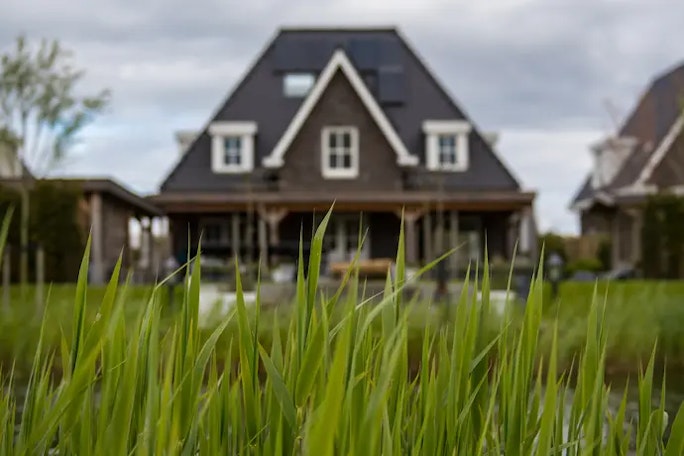Table of contents
If you are looking for a (new) home to buy, a lot is coming your way. You want to know how much you can borrow at most, how to make an offer on a house, what the most strategic offer is, and which legal documents need to be prepared. And this is probably just a small selection of the questions you have... That's why we provide you with an overview of all the steps you will go through during the buying process in this article. This way, you know in advance how it works to buy a house!
Step-by-step plan for buying a home
Below you can read step by step what to expect when buying your home. This way, you know exactly what you need to arrange and what to pay attention to. This step-by-step plan is written for the purchase of existing construction. Different steps apply for the acquisition of a new build home.
Is this your first home purchase? Or are you already feeling stressed at the thought of everything that is coming your way? Then let us say in advance: we really recommend that you hire a broker. It increases your chances of finding é and buying a suitable home and makes the process a lot more pleasant and less stressful. Want to know more about buying your first home? Check out our helpful checklist for buying a house as a starter.
Read more about buying a home:


























- Receive proposals from multiple agents
- Get clarity on costs in advance
- Choose based on performance and results
- Over 3000 people have gone before you
- Free & without obligation
- Independent
- Non-binding
- Free
- Fast
Step 1: Checking your financial possibilities
Before the hunt for a new house can begin, you naturally want to know what price range you can look in. Below you can read about the ways to finance the purchase of a house.
Mortgage
It is likely that you do not have the (full) purchase amount for a new home in your savings account, especially if you are a first-time buyer. In that case, a mortgage is usually needed to finance the purchase. In our article about mortgages, you can read everything you need to know about this loan from the bank. Your maximum mortgage depends on various factors, including your income, expenses, and credit history. Schedule a conversation with a mortgage advisor to calculate how much you can borrow and what your monthly repayments will be.
Own funds
Do you have a nice amount of own funds in your account? You can invest this money in the purchase of your home. This can be savings you've built up over the years, or a gift from a family member or an inheritance. Contributing your own funds has the advantage of reducing the total costs of your mortgage. This results in lower monthly payments. However, always be cautious about contributing (a lot of) your own funds. It's important to ensure you have enough money left for the costs of buying a house.
The exact amount you can invest and how much you need to reserve for additional costs depends on your specific situation and the house you want to buy. It is wise to work with an experienced buyer's agent or financial advisor who can help you determine the right amount of own funds to contribute.
Equity from previous house
If you were already a homeowner and sold your previous house for a good price, you can use the potential equity to finance part of the purchase price of your new home. Additionally, you can use the equity of your house for other purposes, such as funding renovations or lowering your mortgage interest. Seek professional advice here as well and use the equity in the smartest way possible.
Buying a house without a mortgage
If you have sufficient financial resources, you might also consider buying a house without a mortgage. In this way, you become the immediate owner of the property, and your monthly payments decrease. On the other hand, you lose several tax benefits and deductions associated with having a mortgage. In our article about buying a house without a mortgage, we outline the advantages and disadvantages of purchasing a house with your own funds.
It is wise to seek advice from a financial advisor; he or she can help you map out the pros and cons for your specific situation.
Are you buying a new build? Discover here all the costs involved in a new build house.
Step 2: Mapping out the total costs for purchasing a home
When buying a house, you need to take into account a number of additional costs besides the purchase price. The standard costs, also known as costs for the buyer (Kosten Koper), include transfer tax, notary fees, and appraisal fees. These amounts can be significant and must be paid by the buyer. If you purchase a house 'Vrij Op Naam', the seller is responsible for paying these costs.
In addition to these standard costs, you may also encounter additional expenses, such as agent fees, fees for the mortgage advisor, and costs for a bank guarantee. Want to know more? Then take a look at our comprehensive overview of all possible costs when buying a house, including calculation examples.
Step 3: Finding a suitable property
Now that you know how much you can spend on a property, the search for your ideal home begins. There are several ways to do this. Read about them below.
Property websites
One of the most popular ways to search for a new home is by consulting property websites. The most well-known real estate site in the Netherlands is Funda. Here you will find the largest selection of properties for sale in the Netherlands. With the help of filters, you can search for a property that perfectly matches your criteria.
Tip: If you create a Funda account and set up a search request, you will automatically receive the latest property offerings in your mailbox daily. Other well-known property websites are Pararius and Jaap.
Buyer's agent
In the current housing market, people are struggling to find a suitable property within the right price range. And when they finally get excited about a property, it’s often challenging to schedule a viewing (because the agenda for viewings is already full).
Are you facing this problem too? Then it is smart to engage a buyer's agent. They are often the first to know about new properties coming on the market, even before they appear on Funda. This increases your chances of scheduling a viewing. Moreover, agents have local market knowledge and can inform you about new construction projects and other relevant developments.
Open House Day
A special opportunity to view houses is the NVM Open Huizen Dag, which is organized twice a year. During this day, you can visit participating houses without an appointment and talk directly with the owner, giving you a better view of the property and the neighborhood. Participating houses are listed on Funda.
Want to know more about finding an agent?
Discover handy tips and explanations about how Mijn Verkoopmakelaar works.
Have you found a house that you're excited about? Then contact the selling agent as soon as possible to schedule a viewing. Your buyer's agent can assist you with this. Is the appointment scheduled? Then be well prepared for your visit.
Read our tips for viewing a property and create a checklist in advance with your housing wishes and requirements. You can use our handy Property Viewing Checklist for this. This way, you can avoid forgetting to ask or investigate important things during your visit.
Checklist items include checking for:
- Cracks in walls and damp or mold spots
- The condition of the paintwork
- The condition of window frames and windows (check for double glazing, proper insulation, and no leaks or drafts)
- The central heating boiler and kitchen appliances
- The condition of the sanitary facilities, such as the functionality of taps, toilets, and showers
- The state and location of the garden (for example, is there sufficient privacy)
Ask the agent about any defects and thoroughly investigate the property, as you have a duty to investigate as a buyer. Also inquire about the energy label of the property and possible sustainability measures. This can affect the amount you can borrow and future costs. For example, what type of heating system does the property have? And how is the property insulated?
If the seller agrees, it's helpful to take photos. A viewing of a house often goes by in a flash, and this way, you can revisit the property at home in a more relaxed manner. Is the property not decorated according to your taste? Try to look beyond that. Focus on the space, the amount of natural light, and the condition of the house.
Don't forget to explore the neighborhood before or after the viewing. Are all the amenities you consider important available? Is there an atmosphere where you feel at home? If you have questions about the neighborhood and amenities, ask the selling agent. Also, add these questions to your checklist in advance.
Step 5: Determining and making an offer
If you've found your dream home, it's time to make an offer on the property. But before you can do that, you need to determine your ultimate offer and bidding strategy. If you're not well-versed in recent house prices, buying your first house, or if you're not good at negotiating, we strongly recommend engaging a real estate agent. They have knowledge of local property prices, are masters at negotiating, and will help you determine the right bidding strategy.
It's important to set your maximum bid in advance so you don't get caught up in a ruthless bidding war. To determine the right offer, it's a good idea to request recent sale prices of comparable homes in the area from the Cadastre beforehand. This way, you have insight into the value of the property and (when relevant) how much people are typically overbidding in the current market. If you have an agent, they will find this information for you and advise you on it.
The way you make an offer on a house depends on the type of bidding chosen by the seller. Negotiating is the most common form, where you as the buyer make an opening bid and the seller can make a counteroffer. If the sale is happening by registration, the seller will ask for a final bid without negotiations. Online bidding allows you to make a digital bid and make adjustments afterward. A property can also be sold through an auction (public sale).
Read everything you need to know about making an offer on a house.
Step 6: Negotiations
When entering negotiations, you want to be well-prepared. Do you want to know what to pay attention to? The following tips will help you:
- Negotiation strategy: Determine your negotiation strategy in advance (possibly together with the agent). Take into account market conditions and the seller's situation. For instance, has the seller already bought a new home? Has the house been on the market for a while? Or is there a lot of interest? All of these can affect your negotiating position.
- Price: Of course, the price of the house is an important point of negotiation. Make sure to make a realistic offer based on comparable properties in the area and the condition of the house.
- Conditions for termination: Draft clear conditions for termination so that you can withdraw from the sale without cost if, for example, you're unable to secure the mortgage or if serious defects come to light.
- Written offer: Always submit your offer in writing. This creates a legally enforceable document that serves as the basis for further negotiations.
- Professional advice: Consider hiring a buyer's agent. They have experience in negotiating and can advise you on the best strategy to purchase the property under the best conditions.
Step 7: The purchase agreement and the statutory cooling-off period
Have the negotiations been completed and has your offer been accepted? Then the purchase agreement will be drawn up. It's important to thoroughly check this agreement and ensure you understand everything in it before signing. The purchase agreement contains all the agreements and conditions applicable to the purchase. Consider the price, delivery date, conditions for termination, and any movable goods.
It's wise to enlist the help of a real estate agent or legal advisor so you clearly understand the legal implications before signing the purchase agreement. After signing the purchase agreement, you have three days of statutory cooling-off period. During these days, you can withdraw from the purchase at no cost and without stating a reason.
Once you've signed the purchase contract, the official process begins. Usually, a deposit is made or a bank guarantee is issued, depending on the agreements in the contract.
Step 8: The Resolutive Conditions (Structural Inspection and Financing)
Is the purchase contract signed and the reflection period over? Then it is time to verify the resolutive conditions. Common conditions include:
- The stipulation of structural inspection: If you have agreed to a structural inspection, it will be conducted to check the condition of the property. This inspection identifies any hidden defects. A structural inspector documents all findings and prepares a report with recommendations for repairs and maintenance.
- The stipulation of financing: This is the moment when you take action to secure your financing. You submit a mortgage application to the lender (possibly with the National Mortgage Guarantee). They assess whether you qualify based on various factors such as your financial situation, income, expenses, and credit history. To ensure that the purchase amount is reasonable compared to the market value, the lender will send an appraiser to evaluate the property.
If everything is in order, the purchase will proceed. If there are problems (e.g. securing financing or hidden defects), you can withdraw from the purchase without penalty.
Step 9: Transfer
During the transfer, several steps are followed. First, a final inspection is conducted to ensure that the house is in the condition agreed upon in the purchase agreement. Utility meters are recorded, any defects are noted, and (if necessary) repair agreements are made.
Then it's time to go to the notary, where you will be present together with the seller. Your real estate agent will accompany you to the notary. There, the deed of transfer is signed, which transfers the legal ownership of the property. From that moment on, you are truly the owner of your home! At the same time, the mortgage deed is signed, which outlines the agreements with the lender.
Regarding insurance, it is often required to have a homeowners insurance that covers the property. Additionally, it is strongly recommended to take out liability insurance. These insurances provide financial protection in case of damage to the property or accidents on the premises.










